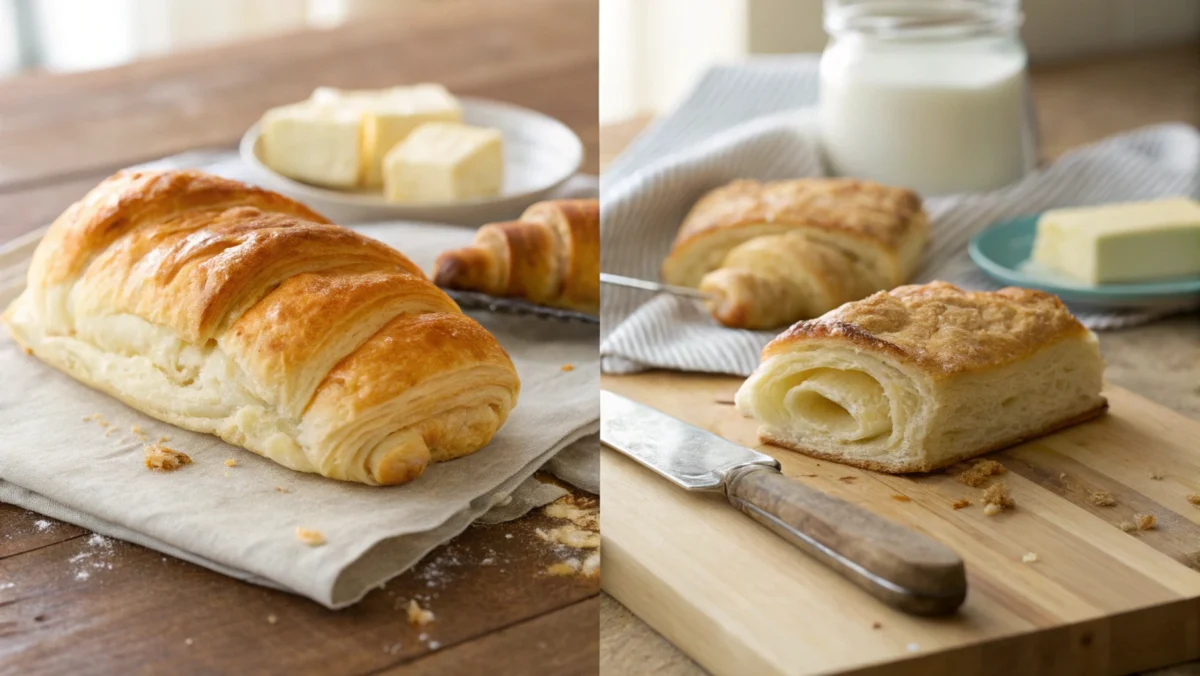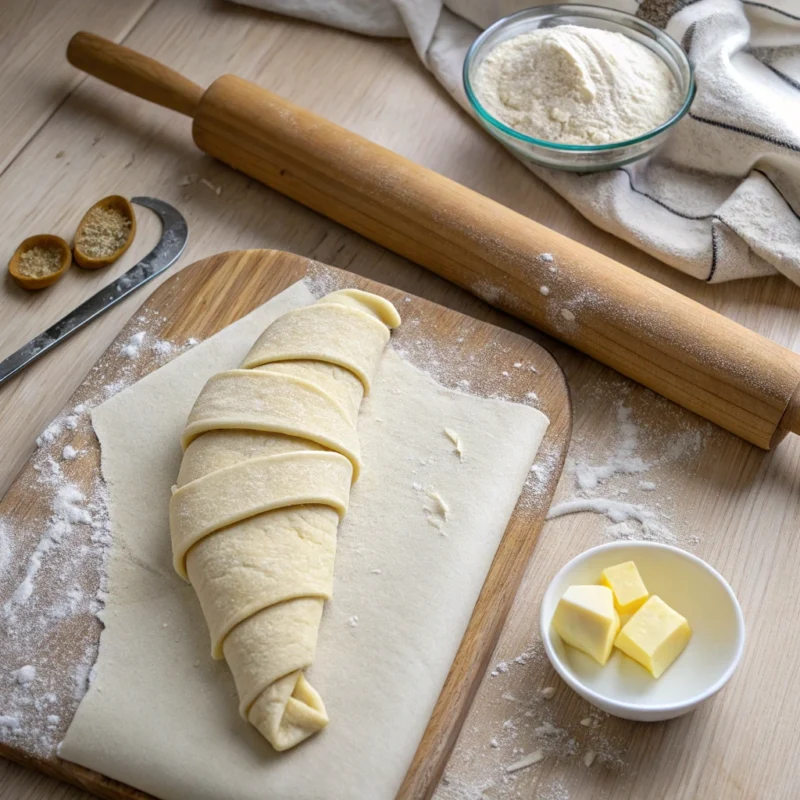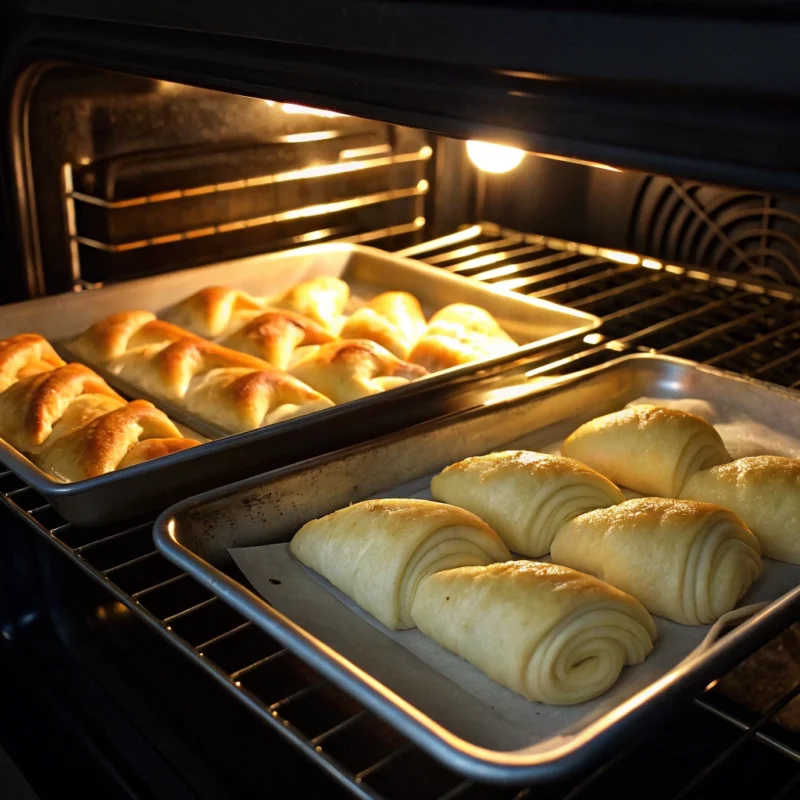
Introduction
When stepping into the world of pastries, it’s easy to confuse crescent dough with puff pastry. After all, both are buttery, flaky, and beloved staples in kitchens worldwide. But here’s the kicker: these two doughs are far from identical. This article unravels their differences, explains their unique uses, and even delves into whether one can substitute for the other. So, if you’ve ever wondered “Is crescent dough puff pastry?”—stick around to get the answers!
Understanding Crescent Dough and Puff Pastry
What is Crescent Dough?
Crescent dough is a soft, yeasty dough that’s often pre-made and sold in cans, making it a popular choice for quick and easy baking projects. The dough contains yeast, giving it a light, bread-like texture once baked. It also typically includes milk, sugar, and butter, contributing to its rich and slightly sweet flavor profile. Crescent dough is commonly rolled into triangles and shaped into crescents before baking, hence the name.
This dough is perfect for creating buttery, airy pastries with a touch of chewiness. You’ll often find it used in breakfast rolls, savory pinwheels, or even quick desserts.
What is Puff Pastry?
Puff pastry, on the other hand, is a laminated dough that’s all about those flaky, crisp layers. Made by alternating layers of dough and butter through a series of folds and refrigerations, puff pastry is a labor of love. When baked, the butter trapped between the dough layers creates steam, causing the pastry to puff dramatically.
Unlike crescent dough, puff pastry is typically unsweetened, making it versatile for both savory and sweet dishes. It’s commonly used for tarts, pies, and appetizers like vol-au-vents.
Are Crescent Dough and Puff Pastry the Same?
Spoiler alert: they’re not. While they may look similar when baked, their ingredients, preparation methods, and end textures set them apart. Crescent dough has a bread-like softness thanks to its yeast content, while puff pastry boasts an unmistakable crunch due to its meticulous lamination process.
If you’re wondering, “Is crescent dough puff pastry?”—the answer is a firm no. However, both have their own charm and specific uses in the kitchen, which we’ll explore further.
Differences Between Crescent Dough and Puff Pastry

Lamination and Layering Techniques
One of the standout differences between crescent dough and puff pastry is how they’re prepared. Puff pastry relies on lamination—a technique where layers of dough and butter are meticulously folded and rolled out multiple times. This process traps butter between the dough layers, and when baked, the butter melts and releases steam, creating the signature flaky texture.
Crescent dough doesn’t go through this complex lamination. Instead, it’s made more like bread dough, with yeast as the key rising agent. The result? A light, airy texture that’s closer to a soft roll than a crispy pastry.
In essence, puff pastry is all about layers, while crescent dough focuses on fluffiness.
Leavening Agents and Ingredients
The ingredients in crescent dough and puff pastry further emphasize their differences. Crescent dough contains yeast, which helps it rise during baking. It also often includes milk and sugar, giving it a slightly sweet flavor and a soft, pliable consistency.
Puff pastry, on the other hand, skips the yeast entirely. It depends on the water content in the butter and dough to create steam during baking. The absence of sugar and yeast makes puff pastry less sweet and more neutral in flavor, which is why it’s equally at home in savory pies or fruit tarts.
Cooking Results and Textural Comparison
When it comes to the final product, crescent dough and puff pastry couldn’t be more different. Crescent dough bakes into a light, airy roll with a soft texture that tears easily. Think croissants or classic dinner rolls—soft, buttery, and a little chewy.
Puff pastry, however, is flaky, crispy, and delicate. Bite into it, and you’ll hear that satisfying crunch. Its thin, crisp layers practically melt in your mouth, making it perfect for recipes where texture is key, like vol-au-vents or mille-feuille.
Why These Differences Matter in Baking

Understanding these distinctions is essential when choosing which dough to use for a recipe. Puff pastry is ideal when you need something that’s crispy and flaky, like a tart crust or a pot pie lid. Crescent dough, with its softer texture, shines in dishes that require a lighter, bread-like consistency.
So, when the question arises, “Is crescent dough puff pastry?” the answer isn’t just no—it’s a reminder that each dough has its unique role in the kitchen. Knowing their differences helps you choose the perfect one for your dish.
Uses of Crescent Dough and Puff Pastry in Baking
When to Use Crescent Dough
Crescent dough is a go-to choice for recipes that call for soft, airy, and buttery textures. It’s particularly beloved for breakfast and brunch dishes. Think croissants, breakfast rolls, and sweet or savory pinwheels. Because crescent dough is pre-yeasted, it rises beautifully in the oven, giving it a light, bread-like consistency.
For a quick treat, crescent dough can be stuffed with chocolate, cream cheese, or jam to create handheld desserts. On the savory side, you can wrap it around sausages for pigs in a blanket or layer it with cheese and herbs for flavorful appetizers.
Another major advantage of crescent dough? Its ease of use. The pre-packaged options available in stores make it perfect for home bakers looking to whip up something delicious without spending hours in the kitchen.
When to Use Puff Pastry
Puff pastry, with its distinct flaky texture, is the star of elegant desserts and savory creations. Its crisp layers make it ideal for tarts, galettes, and mille-feuille. When baked, it has a golden, shattering crust that adds a sophisticated touch to any dish.
In savory cooking, puff pastry excels as a base for pot pies, turnovers, and quiches. It can also be used to create bite-sized appetizers like cheese straws or vol-au-vents, which are perfect for entertaining. For sweet recipes, puff pastry is often paired with fruit, custard, or chocolate, resulting in desserts that are as visually stunning as they are delicious.
Because puff pastry is unsweetened, it adapts well to both sweet and savory recipes, offering versatility that crescent dough lacks.
Crescent Dough vs. Puff Pastry: Matching the Dough to the Dish
Choosing between crescent dough and puff pastry ultimately depends on the dish you’re making. If you want a soft, bread-like texture with a hint of chewiness, crescent dough is your best bet. For dishes requiring flaky, crispy layers that hold up to fillings or toppings, puff pastry reigns supreme.
When deciding, consider the texture, flavor, and structure the recipe demands. Crescent dough is fantastic for comforting, casual dishes, while puff pastry brings a touch of elegance to your culinary creations.
Can Crescent Dough Be Used as a Substitute for Puff Pastry?
Why Substituting May Not Work Well
At first glance, crescent dough and puff pastry might seem interchangeable. They both bake into flaky, golden perfection, right? Not quite. While they may look similar, their unique preparation methods and textures make substitutions tricky.
Crescent dough, with its yeast and soft bread-like structure, lacks the delicate crispness of puff pastry. Recipes that rely on the flaky, shattering layers of puff pastry—like tarts or turnovers—might fall flat (literally!) if crescent dough is used instead. Without the lamination process, crescent dough doesn’t create the airy, buttery layers that puff pastry is known for.
So, is crescent dough puff pastry? No, and their differences can’t always be bridged by swapping one for the other.
Recipes and Modifications to Make It Work
If you’re set on using crescent dough as a substitute, there are a few modifications you can try. Adding layers of butter and folding the dough multiple times can mimic some of puff pastry’s flakiness. While it won’t be identical, it might work for less demanding recipes, like pot pies or simple pastries.
For recipes that require the authentic crispiness of puff pastry, though, there’s no true replacement. Your best bet is to stick with store-bought puff pastry or invest time in making it from scratch.
For more flaky and delicious treats, explore our guide on easy puff pastry dessert recipes.
How to Choose Between Crescent Dough and Puff Pastry
Factors to Consider: Time, Texture, and Taste
Deciding between crescent dough and puff pastry boils down to three main factors: time, texture, and taste. If you’re in a hurry, crescent dough is the more convenient option. Pre-made crescent dough rolls out easily and bakes quickly, making it ideal for last-minute meals or snacks.
For recipes that demand a crisp, flaky texture, puff pastry is the better choice. Its laminated layers create a light and delicate crunch that’s perfect for elegant dishes like tarts and turnovers. However, puff pastry requires more preparation time, especially if made from scratch.
Taste also plays a key role. Crescent dough’s slight sweetness makes it a natural fit for breakfast and dessert recipes, while puff pastry’s neutral flavor works equally well for sweet and savory dishes.
Cost and Convenience
Both doughs are widely available in grocery stores, but they differ in cost. Puff pastry tends to be more expensive due to its labor-intensive preparation. Crescent dough, often sold in cans, is budget-friendly and easier to work with, especially for beginners.
Ultimately, the choice depends on the dish you’re making and your priorities in the kitchen. Whether it’s a quick snack or an elegant dinner, understanding their unique traits ensures delicious results.
FAQs about Crescent Dough and Puff Pastry
Can Pillsbury Crescent Dough Be Used as Puff Pastry?
Not quite! While Pillsbury crescent dough is convenient and delicious, it doesn’t have the flaky layers of puff pastry. Crescent dough is softer and bread-like due to its yeast content, which gives it a more airy texture. Puff pastry, on the other hand, is laminated to create those delicate, crispy layers. For recipes requiring true puff pastry, crescent dough might not deliver the desired results.
Is Crescent Pastry the Same as Puff Pastry?
No, crescent pastry and puff pastry are fundamentally different. Crescent pastry is a yeast-based dough that’s rolled into triangles and baked into soft, fluffy rolls. Puff pastry is a laminated dough made by folding layers of butter and dough repeatedly, creating its signature flakiness. If you’ve ever wondered, “Is crescent dough puff pastry?”—the answer is a definitive no!
Can You Substitute Puff Pastry with Crescent Rolls?
In some cases, yes, but with limitations. Crescent rolls can work as a substitute in recipes where a soft texture is acceptable, such as pot pies or wrapped fillings. However, they lack the crisp flakiness of puff pastry, so the substitution won’t work for tarts or desserts where texture is key.
Is Pillsbury Puff Pastry?
No, Pillsbury offers crescent rolls, which are distinct from puff pastry. While both are versatile and delicious, puff pastry has a laminated structure that Pillsbury crescent rolls don’t replicate.
Conclusion: Understanding the Unique Roles of Crescent Dough and Puff Pastry
So, is crescent dough puff pastry? Now you know the answer is a resounding no. While both are beloved staples in the kitchen, they serve very different purposes. Crescent dough offers a soft, bread-like texture perfect for breakfast rolls and quick snacks. In contrast, puff pastry’s flaky, crisp layers elevate elegant desserts and savory dishes.
When baking, it’s essential to choose the right dough for the recipe. While crescent dough can sometimes act as a substitute for puff pastry in simple recipes, it won’t replicate the delicate crunch or visual appeal of true laminated dough.
Whether you’re preparing a comforting pot pie or a show-stopping mille-feuille, understanding these differences ensures you’ll always have the right dough for the job. With a little planning, both crescent dough and puff pastry can shine in your culinary creations.
